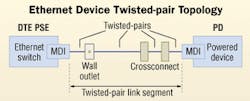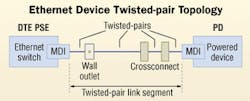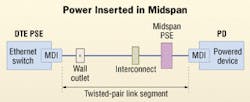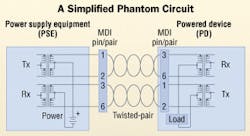Powering Ethernet devices over data cabling
802.3af extends the benefits of Ethernet to markets in need of a simple, cost-effective networking solution.
The prime objective of the IEEE 802.3af task group is to develop a standardi that will extend the capability of Ethernet over twisted-pair. The implementation will allow power to be delivered along with data over 10BASE-T, 100BASE-T, and 1000BASE-T twisted-pair link segments.
The standard is poised to enable a new class of low-power Ethernet devices in markets where there are a plethora of proprietary vendor solutions in need of a unifying communication protocol and a common networking infrastructure. Examples include building automation systems, industrial and home automation, security access control and monitoring systems, lighting control, and entertainment equipment.
It can be also used in applications where a lack of remote power provisioning has limited the use of an Ethernet solution. Examples include IP telephony, wireless access points, and point-of-sale terminals.
Structured cabling applications
10/100/1000BASE-T twisted-pair Ethernet devices are designed to operate over a twisted-pair link segment that consists of cable, connecting hardware, and a recommended topology (see figure, Ethernet Device Twisted-pair Topology). The topology is similar to the ANSI/TIA/EIA-568-B.1 cabling channelii.
Two types of power sourcing equipment (PSE) are specified in the 802.3af standard: data terminal equipment (DTE), and midspan.
Power can be sourced directly from the network equipment providing the data; the network equipment that sends and receives Ethernet data is called data terminal equipment. These types of power devices are called DTE power sourcing equipment (DTE PSE).
Power can also be achieved by inserting power-sourcing equipment on pin-pair assignments (4, 5) and (7, 8) of the twisted-pair link segment between the DTE and the device to be powered. These powering devices are called "midspan" power-sourcing equipment, which permits the power to be supplied external to the Ethernet equipment. This provides both data and power on the twisted-pair link segment without burdening each port of the Ethernet equipment with the need to provide power, and will permit the support of legacy Ethernet equipment that lacks powering capability.
Work remains to validate the assumptions and practicality of these uses. The current specification requires that the transmission performance and the cabling channel length be maintained after insertion of the midspan PSE. To insert the midspan PSE and maintain the channel performance, the transmission performance is assumed to be either equivalent to a mated connector or to an equipment or work area cable. Based on these assumptions, it is proposed that the midspan PSE can replace one of these components in the allowed topology without affecting the cabling channel performance.
Two examples are given in the standard: A midspan PSE and an interconnect may be used to replace the crossconnect; or the midspan PSE may replace the equipment cable or the work area cable with a cable that includes a PSE. (Note: DTE PSE applies to 1000BASE-T. Midspan PSE does not.)
The media-dependent interface (MDI) for 10/100/ 1000BASE-T is the 8-position modular jack (specified in ISO/IEC 603.7). For power sourced from 10BASE-T, 100BASE-T, and 1000BASE-T devices (DTE PSE), the power is provided on the same pin-pair assignments as the data-that is, TX (1, 2) and RX (3, 6). For power inserted midspan (midspan PSE), the pin-pair assignments (4, 5) and (7, 8) are used.
The midspan power is implemented on the pairs not used for 10/100BASE-T equipment. Midspan power cannot be used with 1000BASE-T. Alternate A MDIX and Alternate A MDI polarities are reversed to account for the MDI-X, which provides an internal crossover function.
Power is superimposed on the data pairs similar to the "phantom" DC circuits in token ring used to insert a station into the ring. In 802.3af, powering involves utilizing the secondary winding center taps of the transmitter and receiver transformers at each end of the link. The conductors of the pairs, connected across the transmit-and-receive secondary windings, provide both halves of the DC powering circuit. Midspan power is achieved in a similar fashion, by inserting power-sourcing equipment on pin-pair assignments (4, 5) and (7, 8) of the twisted-pair link segment .
Cabling issues
Although powering over Ethernet is targeted to operate on the 10/100/1000BASE-T twisted-pair link segments, additional transmission performance parameters are required for operation that are not completely characterized in either of the telecommunications cabling standards referenced by IEEE 802.3 (TIA/EIA-568-A, and ISO/IEC 11801) or in the 10/100/1000BASE-T standards.
Performance parameters not completely characterized are related to the power delivery method. They include resistance, resistance unbalance, current capacity, voltage capacity, and power capacity. In addition, cabling performance parameters need to be added that will limit the mode coupling between the data and power circuits. Mode coupling can cause power supply noise to interfere with the data signals and create conducted and radiated emissions.
TIA-TR42-the TIA/EIA Engineering Committee responsible for User Premises Telecommunications Cabling Infra structure-is evaluating the IEEE 802.3af specification. A task group has been assigned to identify the cabling channel performance required, plus evaluate the use of the midspan PSE-both the implementation and transmission performance. The outcome will likely result in an addendum to TIA/EIA-568-B.1 and TIA/EIA-568-B.2, which will address all of the requirements to ensure full support of IEEE 802.3af. (IEEE 802.3 uses the TIA-568 series of standards and their addenda as a normative cabling reference. )
The PSE recognizes whether it should supply power to the PD by applying test voltages-used to determine the PD's load characteristic. These characteristics are known as the PD detection signature. The PSE reads the PD detection signature to determine whether to supply power and how much. The detection signature lets the PSE provide the right level of power, providing a form of power regulation.
The PSE's important functions are to identify the PDs that are enabled to receive power, provide required power levels, and remove power in the event the PD is disconnected from the link. The detection mechanism is an extremely important function of the PSE, to circumvent the application of power to the wide range of devices that can be plugged into the 8-position modular jack. The PSE output voltage range is 44 V to 57 V, providing a maximum output current of 350 ma and a continuous output power minimum of 15.4 W over the range of output voltages.
Framework for smart buildings, phones
The integration of building automation systems in support of an intelligent building design have been proposed in a variety of manifestations over the last decade, each failing to generate much interest. Examples of intelligent buildings are scattered about the world, each promoting their uniqueness. Therein lies the problem. One-of-a-kind solutions are, by definition, not easily repeatable, scalable, or extensible.
The framework for the design of an acceptable standards-based integrated building automation system must include a unifying communication protocol between building technologies, and a common networking infrastructure. For example, Ethernet provides a standards-based protocol with a common networking infrastructure. With the addition of the 802.3af standard, enabling remote power provisioning for building technologies, Ethernet can provide a viable solution for the design of interoperable building technologies and the framework for the design of standards-based building automation systems.
In support of defining a common network infrastructure for BAS, TIA-TR42 has initiated a project (SP-3-4655-A) to develop a standard to enable the planning and installation of a structured cabling system for building automation systems in commercial buildings. The standard will be released as TIA/EIA-862. The project is running in parallel with the 802.3af development.
Power for the early telephone sets was sourced from batteries located near the telephones. Over time, the source of power was provided remotely from the telephone company. Centralized remote power, with battery back-up, provided on the same wires as the communication circuits, has enhanced the telephone's reliability and ease of use.
To succeed, however, the IP telephone must offer more functionality than is currently available in competing telephony products. Traditional phone operation does not require plugging the phone into the AC outlet. The 802.3af standard will simplify the operation of IP telephones by providing both power and data on one cable.
Summary
The 802.3af standard will extend the benefits of Ethernet functionality to markets in need of a simple, reliable, and cost-effective networking solution. Steven Carlson, chair of the IEEE 802.3af DTE task force and co-chair of the Entertainment Industry Technology Association (ESTA) Protocol Working Group, states: "Power over Ethernet will act as a terrific enabling force in building networks for the entertainment industry where compact, remotely-powered networked control devices will save on system cost and complexity, and increase reliability for end-users."
i All references to the standard apply to IEEE P802.3af/ D3.0: Data Terminal Equipment (DTE) Power issued November 15, 2001 and are subject to change.
ii Cabling channels as specified in ANSI/TIA/EIA-568-B.1 exclude the equipment connectors and may include an optional transition/consolidation point connector. The building cable is referred to as horizontal cable.
Chris DiMinico is chief technology officer and vice president of Cable Design Technologies network divisions.



